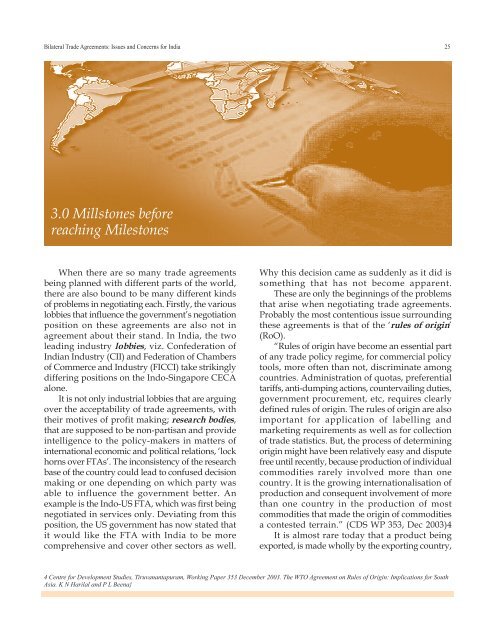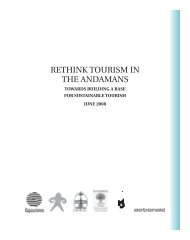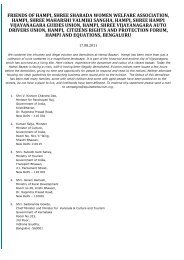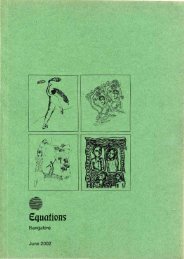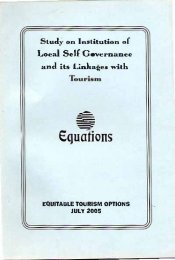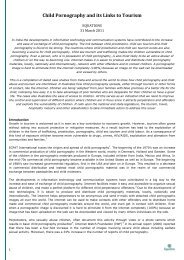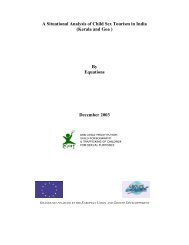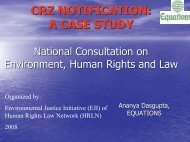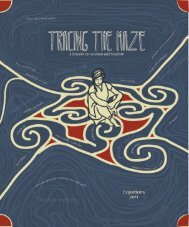Bilateral Trade Agreements â Issues and Concerns for ... - Equations
Bilateral Trade Agreements â Issues and Concerns for ... - Equations
Bilateral Trade Agreements â Issues and Concerns for ... - Equations
Create successful ePaper yourself
Turn your PDF publications into a flip-book with our unique Google optimized e-Paper software.
<strong>Bilateral</strong> <strong>Trade</strong> <strong>Agreements</strong>: <strong>Issues</strong> <strong>and</strong> <strong>Concerns</strong> <strong>for</strong> India 25<br />
3.0 Millstones be<strong>for</strong>e<br />
reaching Milestones<br />
When there are so many trade agreements<br />
being planned with different parts of the world,<br />
there are also bound to be many different kinds<br />
of problems in negotiating each. Firstly, the various<br />
lobbies that influence the government’s negotiation<br />
position on these agreements are also not in<br />
agreement about their st<strong>and</strong>. In India, the two<br />
leading industry lobbies, viz. Confederation of<br />
Indian Industry (CII) <strong>and</strong> Federation of Chambers<br />
of Commerce <strong>and</strong> Industry (FICCI) take strikingly<br />
differing positions on the Indo-Singapore CECA<br />
alone.<br />
It is not only industrial lobbies that are arguing<br />
over the acceptability of trade agreements, with<br />
their motives of profit making; research bodies,<br />
that are supposed to be non-partisan <strong>and</strong> provide<br />
intelligence to the policy-makers in matters of<br />
international economic <strong>and</strong> political relations, ‘lock<br />
horns over FTAs’. The inconsistency of the research<br />
base of the country could lead to confused decision<br />
making or one depending on which party was<br />
able to influence the government better. An<br />
example is the Indo-US FTA, which was first being<br />
negotiated in services only. Deviating from this<br />
position, the US government has now stated that<br />
it would like the FTA with India to be more<br />
comprehensive <strong>and</strong> cover other sectors as well.<br />
Why this decision came as suddenly as it did is<br />
something that has not become apparent.<br />
These are only the beginnings of the problems<br />
that arise when negotiating trade agreements.<br />
Probably the most contentious issue surrounding<br />
these agreements is that of the ‘rules of origin’<br />
(RoO).<br />
“Rules of origin have become an essential part<br />
of any trade policy regime, <strong>for</strong> commercial policy<br />
tools, more often than not, discriminate among<br />
countries. Administration of quotas, preferential<br />
tariffs, anti-dumping actions, countervailing duties,<br />
government procurement, etc, requires clearly<br />
defined rules of origin. The rules of origin are also<br />
important <strong>for</strong> application of labelling <strong>and</strong><br />
marketing requirements as well as <strong>for</strong> collection<br />
of trade statistics. But, the process of determining<br />
origin might have been relatively easy <strong>and</strong> dispute<br />
free until recently, because production of individual<br />
commodities rarely involved more than one<br />
country. It is the growing internationalisation of<br />
production <strong>and</strong> consequent involvement of more<br />
than one country in the production of most<br />
commodities that made the origin of commodities<br />
a contested terrain.” (CDS WP 353, Dec 2003)4<br />
It is almost rare today that a product being<br />
exported, is made wholly by the exporting country,<br />
4 Centre <strong>for</strong> Development Studies, Tiruvanantapuram, Working Paper 353 December 2003. The WTO Agreement on Rules of Origin: Implications <strong>for</strong> South<br />
Asia. K N Harilal <strong>and</strong> P L Beena}


